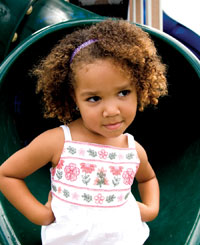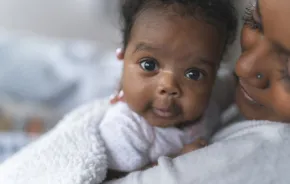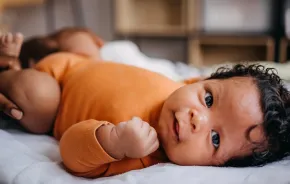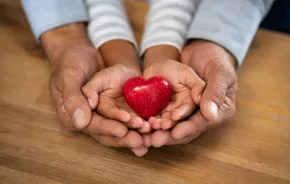Stories about childhood obesity flood the airwaves. Our children are eating too much junk and getting too little exercise — and many are paying the price in worsening health and self-esteem. But there’s another side to this problem that deserves a little ink, the flip side: Girls as young as 5 are becoming painfully aware of their so-called body images.
 When my own daughter was just a tot, I recall one of her baby-sitters telling me about her student-teaching experiences. Naturally tall and slender, she was shocked to hear her first-grade students’ comments about her looks. “You’re so pretty,” they’d say, “so thin!”
When my own daughter was just a tot, I recall one of her baby-sitters telling me about her student-teaching experiences. Naturally tall and slender, she was shocked to hear her first-grade students’ comments about her looks. “You’re so pretty,” they’d say, “so thin!”
A recent study by researcher Abigail Natenshon found that as early as first grade, children are reporting concerns about their weight and body shape. They’re also beginning to restrict food. When — and more importantly, why — did thinness show up on little girls’ radar?
Blame the media?
Some say you can blame it on Barbie, with her unnatural physique. Scaled to human proportions, she’d be 5 feet 9 inches tall and weigh 110 pounds, with measurements 39–18-33. But Barbie’s been around for 50 years, and though many a preteen (myself included) have been deluded into thinking that Barbie’s was an attainable shape, the thin-conscious preschooler is a relatively new phenomenon.
That could be because children are given Barbies (and now the usurping Bratz dolls) at a younger age these days. Though the recommended range for these toys is 6–10, it is not unusual to see 3-year-olds with one in tow. The Web site How to Love Your Body includes speculation that, as the preschool girl dresses these dolls, she is taking in an unnatural example of the size, shape and proportions of the female body — long before her conscious mind is able to separate the toy from reality.
Other suspects? The thinner-than-thin animated heroines of more recent Disney movies and animé. Compare the figures of Ariel (the little mermaid) and Snow White and you’ll see the difference: Ariel’s waist is so tiny, it’s not much thicker than her neck!
But little girls have always aspired to be beautiful princesses; we can blame that one on the Brothers Grimm — who were on the cutting edge of media in their day. But it seems today’s media has taken the concept of “beauty equals goodness” to new extremes. Combine that with easy access to the message and our tots are bombarded at every turn.
Corinne A. Gregory, founder and president of Social Smarts, a Bellevue company dedicated to building social-skill-building curricula for schools, says that part of the problem lies with society: We are becoming increasingly self-aware and self-absorbed. “Where we used to only worry about body image in teen girls, that awareness has drifted down to younger and younger girls,” she says. “When you consider the ‘heroes’ our daughters are being offered — like Miley Cyrus — there is a trend to glamorize these young girls at earlier ages. Their hair, their dress, their experiences in the shows — all of this is geared to appeal to girls in grade school and even earlier.”
So, if we can just keep our tots away from fashion dolls, movies and television, they’ll grow up with healthy body images — right? Unfortunately, it’s not that simple. As with every aspect of raising a child, parental influence has as big an impact as all the outside factors combined.
In her book Moms and Daughters: Promoting a Positive Body Image, Margarita Tartakovsky, M.S., says that a mother’s own body image can have a huge influence on their daughter’s sense of self-worth. “Research has shown that self-criticism and constant dieting are habits that can get passed on to your daughter,” she says. “And moms who are concerned about their weight were more likely to have daughters who are concerned about their bodies.”
Fathers, too, can unknowingly have a negative effect on their daughters’ self-image. Abigail Natenshon’s study, "Childhood Fears Take New Form: Body Image Concerns in Young Children," cites the telling examples of one father who criticizes a television personality for how fat she looks, and another who jokingly tells his 5-year-old that “she will develop a ‘Buddha belly’ if she puts butter on her bread.”
Why worry?
There is little doubt that taken together, these messages are hurting little girls. A U.S. Dept. of Health and Human Services task force found that 80 percent of girls in elementary school have “bad feelings about their bodies,” and that this issue diverts their attention away from schoolwork and friendships. And there’s worse news. “Body-image concerns may be precursors to eating disorders,” Natenshon says.
In fact, anorexia and other eating disorders are most prevalent in teens, but have been documented in children as young as 3. Shannon Cutts, author of Beating Ana, How to Outsmart Your Eating Disorder and Take Your Life Back, blames the $60-billion-a-year beauty, fashion and weight-loss industries that prey on the 96 percent of the population who are not naturally thin and beautiful. “This is why girls as young as 3 are now concerned about having fat thighs and 80 percent of fourth-graders fear getting fat more than cancer or the death of their parents,” she says.
What can parents do?
First, examine your own body image and the messages you’re sending your kids, suggests author Tartakovsky. If you must diet, explain that it is for health reasons — to be fit, live longer, prevent cancer, etc. — rather than to look thinner. Make exercise a regular part of your family’s activities, promoting strength and endurance rather than toned muscles and flat abs. Keep any negative thoughts about your own body — and your child’s! — to yourself.
Limit media exposure when you can. Think about the messages television shows, magazines and fashions may be sending your impressionable preschooler. Shannon Cutts recommends parents have regular discussions about the media images and messages their children encounter, “breaking them down, decoding the advertising messages, and teaching young girls and boys how to fight back by saying ‘no’ to unreasonable beauty standards.”
Swap out Barbie and Bratz for more realistic “little girl” dolls, like the 18-inch American Girl doll or Target’s more-affordable Our Generation doll. Encourage friends and family to do the same when it’s gift-giving time.
We may never go back to the time when preschoolers were oblivious to dieting tips and ab crunches, but we can make sure they understand that people come in all shapes and sizes. It’s trite but it’s so true: “It’s what’s inside that counts.”
Andrea Leigh Ptak is a freelancer writer in South Seattle who, at 5 feet 1 inch, knew she could never be Barbie and has managed, so far, to keep her own daughter from falling into the trap.









